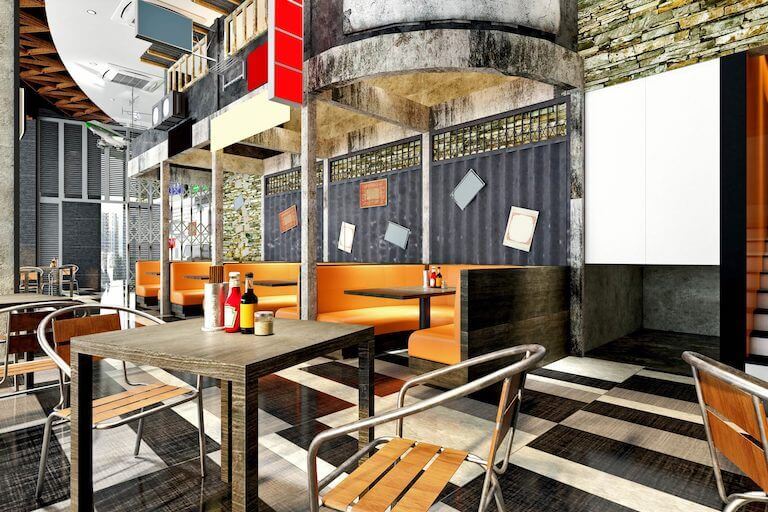Here’s the truth about starting a restaurant. According to a study by Cornell University, over 26% of independent restaurants don’t survive their first year and nearly 60% fail by their third year. That’s why creating a solid restaurant business plan is so important. It may give you an opportunity to put concrete structure around your thinking and assess your ideas from a higher viewpoint, before spending a single dollar.
Although there are no guarantees in life (and especially in business) with a little preparation, education, and mentorship, you can avoid many of the pitfalls that upend others. In this article, you’ll discover how to begin writing a restaurant business plan—and how you can get an education that may help you start your own foodservice business.
Define Your Business Concept
A business plan should start with a basic conceptual overview. Where did the idea for your restaurant or food business come from? And how is your idea unique compared to what else is currently in the market? Who is your target market, and what (in general) will you be serving them?
Think of the concept as the bird’s eye view of your business.
You may also wish to include a mission statement in this section. This will be a short sentence or two that outlines the value the business provides to customers and employees, and may set an inspirational objective. A good example is The Kitchen American Bistro in Boulder, Colorado, which has the following mission:
“We believe in the power of good food and good drink to connect people as family, friends and a community. The Kitchen remains committed to our mission of creating community through food.”*
Verbalizing the bigger picture as a stated mission gives your business depth beyond just making money. When you use it as a guiding principle, it will be reflected in your marketing, operations, and the attitudes of those who join your team.
Do a Market Analysis
Where will your proposed restaurant fit into the overall foodservice market? Is there a niche in your area that’s not being served? Or will you be competing with established businesses? And if so, how will your concept stand out?
Everything from local factors like lack of competition to nationwide factors like a booming economy can contribute to your restaurant’s success or failure. A market analysis can help you to assess both the challenges and opportunities that you’ll face when you open your doors.
Food Entrepreneurship at Escoffier
Dive into greater detail on many of the topics covered in this article in Escoffier’s Food Entrepreneurship programs. The Culinary Entrepreneurship course specifically explores topics like business planning and begin writing a business plan.
Describe Your Service Style
Will your restaurant be fine dining? Counter service? An all-day café with servers? A buffet? A beer garden?
Make sure it’s clearly defined. If your service style is simple, you may include this in your concept section. But if it’s more complex, it may warrant its own section in your business plan. For example, perhaps you plan to offer elevated table service with a number of thoughtful touchpoints. You’ll want to be very clear about what that will look like.
Your service style will directly impact your staffing levels, which will affect your labor costs. That’s why it’s vital to include this information and the associated cost estimates in your business plan.

A full-service waitstaff like this will be more costly than a lean counter-service staff.
Build Your Sample Menu
A great restaurant menu is specifically designed to appeal to your target market, while staying true to your concept. Even if you’re not 100% sure what your final restaurant menu will include, create a sample version for your business plan.
The menu is your product, and it will impact everything about your restaurant from food costs (typically between 25% and 35% of the menu price) to the number of cooks you’ll need to the layout of your kitchen.
You should also calculate pricing for this menu to verify if it can be served at a price point that fits with your target demographic. A family-friendly spot with $20 burgers, for example, is creating a disconnect between its target market and its menu price.

The Science Behind Menu Design
Creating and designing a menu can be complex. You have to balance the art of making great food with the practicalities of food and labor costs. In Escoffier’s Food Entrepreneurship programs, students may explore topics like visual design and price analysis.
Determine Your Facility Design and Location
Once you have a sense of your concept and menu, you can begin to plan what your restaurant should look like and where it will be.
The kitchen is the most expensive part of a restaurant’s total cost. And every square foot taken up by cooking space is a square foot that can’t hold customers. Industry wisdom states that a kitchen should be between 25% and 30% of the total restaurant space—including storage. So you have to plan your kitchen as efficiently as possible.
In the dining room, you’ll need tables and chairs, possibly a host stand, and maybe a bar. You may have plans for art and custom light fixtures, or a high-end tap system for draft beer. Renderings from your architect and/or interior designer can help to show what you’re envisioning.
Include all of the equipment, furnishings, and supplies that you plan to purchase for both the back of house and front of house, so you can estimate the cost of building out your restaurant.
You will also need to decide where your restaurant will be. This will impact rent, guest parking, foot traffic, and even your operating hours. If you’re in a business district, for example, you may choose to only be open for lunch.

Choose Your Management Team and Determine Staff Needs
A great plan without a great team is likely to fail. An important part of your business plan is determining the various roles and responsibilities for your managers and employees.
Depending on the size of your business, your plan may include an organizational chart that explains which position is reporting to whom, how many people you will be hiring, the main skill sets of the management team, and the unique things that each employee brings to the table.
You can also call out any special achievements or accolades for the managers you plan to bring on board, like a general manager with a great deal of experience or a chef with impressive certifications.
If you attend culinary school or enroll in a food entrepreneurship program, some of those team members could even be former classmates. Business is ultimately about the relationships between people, and culinary school is a ripe environment to build those critical connections that may serve you down the road.
Forecast Your Costs, Revenue, and Potential Profit
Anyone looking to launch a foodservice business probably wonders how much the whole endeavor is going to cost, and what the return on investment might be. If you’ve gone through all of these steps, you’ll be well on your way to better awareness of the fundamental costs of business and what you can do to help guide it toward being a profitable venture.
Your business plan should detail the financing that will be required to get your business up and running, the associated costs of marketing and staff, and variable costs such as ingredients. Your business plan should be sufficiently detailed to estimate the profits and expenses for the first few years of your business, in order to help ensure that your plan is economically feasible.

Keeping An Eye On Restaurant Profits
Restaurant profit margins are relatively low compared to other businesses. A key course in Escoffier’s curriculum for the Food Entrepreneurship Associate Degree explores managerial accounting concepts, culinary math, and an overview of basic business accounting transactions such as how to read financial statements. It may explain the practical application of these concepts to the hospitality industry and how to manage costs for long-term profitability.
Create a Marketing Plan
The first step in restaurant or food truck marketing is to identify who your ideal customer will be. Are they looking for date spots, family-friendly restaurants, or group dining? What do they like to eat? What are their wants and needs? Will you be targeting specific dietary profiles, like vegan, paleo, or gluten-free?
Once you know who your customers are, how will you reach them? You will probably need to start a website, including your location, hours, and menu. You may also choose to promote your restaurant on social media, sharing photos and videos on platforms like Twitter, Instagram, TikTok, and Facebook. You can also work with local food influencers, leveraging their larger platforms to spread the word about your new restaurant.

Share photos taken by your customers to connect with your audience.
While your marketing plan is sure to change and evolve over time, it’s wise to have a general strategy in place before you open your doors so you can have a successful grand opening.
Marketing 101
Escoffier’s Food Entrepreneurship programs include coursework in food styling and photography, social media, and hospitality marketing. Graduates could be prepared to identify their ideal customers and reach them for better visibility and higher sales.
An Entrepreneurial Education Can Mean Being Prepared
While it is obvious that you need a passion for the world of food and drink before launching a food service business, starting any venture is difficult without mentorship from professionals who have real-world experience.
In Escoffier’s Food Entrepreneurship programs, students can work with skilled experts from the culinary world who may help them avoid the pitfalls common to new business owners. A blend of culinary theory and practical, hands-on business operations experience can prepare students for the intricacies of foodservice, with a steady eye on profitability.
To learn more about what students can expect in our Food Entrepreneurship programs, get in touch with our Admissions Department. They can answer your questions and help you develop a plan to get closer to your dreams of business ownership.
Enjoyed this article? Here are a few more you may like.
- How to Start a Restaurant with Little to No Money
- Ghost Kitchens & Ghost Restaurants: What Are They and How Do You Start One?
- The Complete Guide to Starting a Home-Based Catering Business
*Information may not reflect every student’s experience. Results and outcomes may be based on several factors, such as geographical region or previous experience.
This article was originally published on June 29, 2020, and has since been updated.



